虛擬現(xiàn)實(shí)還有希望崛起嗎,?| VR興衰史
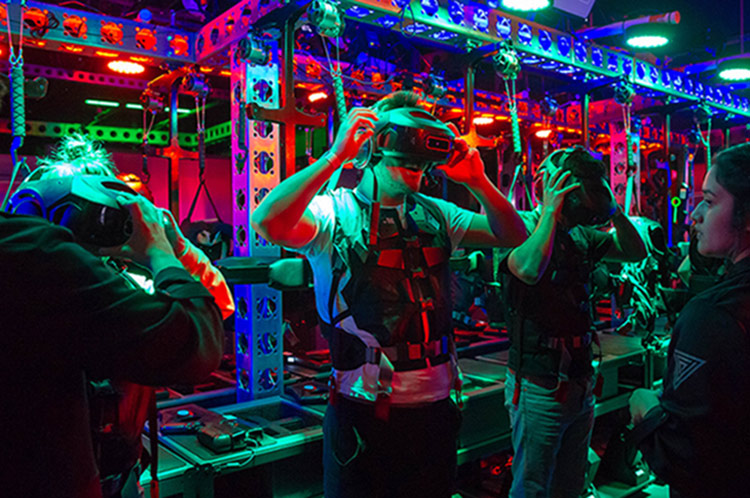
|
在一位自行車修理工一定程度的協(xié)助下,,保羅·麥卡特尼為虛擬現(xiàn)實(shí)的未來(lái)做出了些許貢獻(xiàn),。 偉大的披頭士樂(lè)隊(duì)成員、帕洛阿爾托一家自行車商店的修理工以及一項(xiàng)前景光明但也許未能充分發(fā)揮潛力的技術(shù)——?jiǎng)倓偲鸩降恼障鄼C(jī)公司Jaunt VR富于進(jìn)取精神的高管斯科特·布魯克讓這幾個(gè)看似不相干的元素重疊在了一起,。2014年,,布魯克花50美元雇了一位修理工,讓他騎著BMX小輪車圍著一處滑板公園繞圈,,同時(shí)用可以360度錄音錄像的專用相機(jī)把前前后后,、上上下下的聲音和影像都錄了個(gè)遍。布魯克希望這輛小輪車圍繞滑板公園行進(jìn)時(shí)由其鏈條發(fā)出的聲音能夠成為理想的Ambisonic格式音頻,,也就是全方位圍繞著收聽者的環(huán)境音,。 幾個(gè)月后,布魯克設(shè)法讓麥卡特尼看了當(dāng)時(shí)錄的一段影像,。麥卡特尼深受觸動(dòng),,當(dāng)即邀請(qǐng)Jaunt VR為他的演唱會(huì)錄像。時(shí)間是第二天晚上,地點(diǎn)是舊金山久負(fù)盛名的燭臺(tái)公園,,也就是披頭士樂(lè)隊(duì)在48年前進(jìn)行謝幕演出的地方,。Jaunt VR迅速采取行動(dòng),制作了最早的VR影像之一,。這部沉浸式體育場(chǎng)演唱會(huì)電影可以讓觀眾體會(huì)到站在跳動(dòng)的人群中的感覺(jué),。2016年,布魯克離開了Jaunt VR,,隨后一年在YouTube做“全球VR推廣人”,。但他仍然將那部演唱會(huì)電影視為一項(xiàng)突破性成就?!拔覀冧浵铝吮A_·麥卡特尼在人們面前演唱的片段,,這種錄影方式,在100年后看來(lái),,也許就像我們現(xiàn)在看黑白電影一樣”——原始但具有開創(chuàng)性,。“那是一種很有力量的東西,?!?/p> 這個(gè)精彩的比喻是虛擬現(xiàn)實(shí)推廣者的標(biāo)準(zhǔn)說(shuō)辭。大家可以想象一下那些粗糙的電影畫面——帶著高頂禮貌的人在馬車和福特T型車之間無(wú)聲無(wú)息地走動(dòng),。就像電影能夠向觀眾展示他們從未去過(guò)的地方一樣,,虛擬現(xiàn)實(shí)可以把觀眾直接帶進(jìn)這樣的場(chǎng)景之中。正是看到了這樣的前景,,F(xiàn)acebook才在2014年出資30億美元收購(gòu)了VR頭盔制造商Oculus VR,,推廣人才會(huì)在那之后年復(fù)一年地宣稱VR是下一個(gè)新事物。谷歌,、HTC,、三星和索尼等消費(fèi)電子公司也像Facebook一樣,爭(zhēng)相在市場(chǎng)上推出已經(jīng)為消費(fèi)者做好準(zhǔn)備的VR頭盔,。風(fēng)投人士為內(nèi)容開發(fā)和硬件應(yīng)用投入了幾十億美元,。《時(shí)代》雜志將22歲的Oculus創(chuàng)始人帕爾默·拉基搬上了封面,,并宣稱虛擬現(xiàn)實(shí)技術(shù)“即將改變世界”,。馬克·扎克伯格也在2017年說(shuō)出了“希望10億人使用Oculus頭盔”的豪言壯語(yǔ),只是他沒(méi)有說(shuō)什么時(shí)候會(huì)實(shí)現(xiàn),。 |
Paul McCartney made his modest contribution to the future of virtual reality with a little help from a bike mechanic. The unlikely union of the Beatles great, a bike-shop employee in Palo Alto, and a promising if underachieving technology is the accomplishment of Scott Broock, once an enterprising executive with a fledgling camera company called Jaunt VR. In 2014, Broock offered to pay the mechanic $50 to ride around a skate park on a BMX bike while being filmed with a specialized camera rig that could shoot video and record sound in 360 degrees—all around and up and down. Broock hoped the bike’s chain clanging around the fishbowl would be ideal for something called ambisonic audio, surround sound hearable above, below, and around the listener. A few months later, Broock managed to show a clip of the video to McCartney, who was so impressed that he invited Jaunt to film his concert the very next night at San Francisco’s historic Candlestick Park, the same venue where the Fab Four had performed their final show 48 years earlier. The startup company quickly mobilized and recorded one of the first videos of its kind, an immersive stadium concert film that would give a viewer the sensation of being among the pulsating crowd. Broock left Jaunt in 2016 and subsequently served a yearlong stint as a “global VR evangelist” for YouTube. But he still looks back at the concert video as a breakthrough achievement. “There’s a moment recorded in time of Paul McCartney playing in front of people captured in a way that, maybe 100 years from now, seems like black-and-white films”?—primitive but pioneering. “That’s a powerful thing.” The vintage film comparison—think: grainy footage of silent passersby shuffling around in top hats among horse-drawn carriages and Model T–esque cars—is standard fare for virtual reality’s boosters. Just as movies showed viewers places they’d never go, VR would transport them directly into those same filmed environments. That was the promise that led Facebook to pay $3 billion for headset maker Oculus VR in 2014, and every year since, evangelists have proclaimed virtual reality the next new thing. Consumer tech players including Google, HTC, Samsung, and Sony joined Facebook in a race to bring consumer-ready headsets to market. Venture capitalists poured billions into content development and hardware applications. Time magazine put the then-22-year-old founder of Oculus, Palmer Luckey, on its cover and announced the technology was “about to change the world.” Mark Zuckerberg in 2017 famously said he wanted a billion people to be using Oculus headsets—though he conspicuously didn’t say by when. |
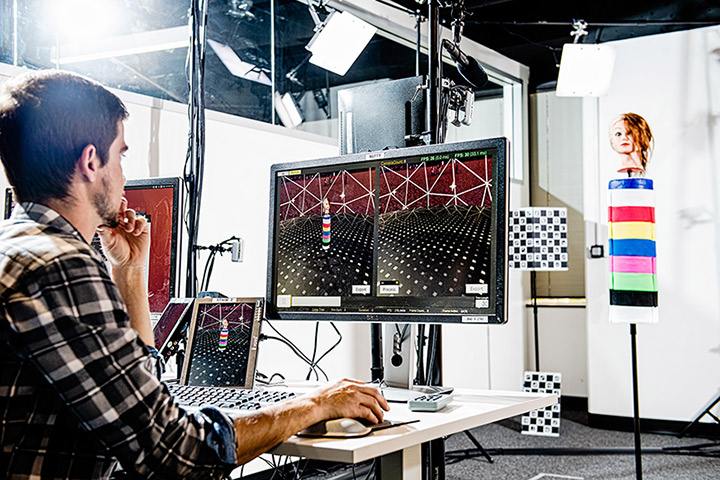
|
扎克伯格避而不談時(shí)間問(wèn)題可以理解。這是因?yàn)樵谒谐涑庵醋鞯念A(yù)言中,,虛擬現(xiàn)實(shí)對(duì)美國(guó)人的日常生活來(lái)說(shuō)仍然處于虛幻之中,。舉例來(lái)說(shuō),據(jù)尼爾森公司旗下專門研究游戲行業(yè)的機(jī)構(gòu)SuperData介紹,,2018年Oculus的旗艦VR頭盔Oculus Rift只賣出了35.4萬(wàn)個(gè),。而IDC的數(shù)據(jù)顯示,當(dāng)年索尼賣出了1700萬(wàn)多臺(tái)PlayStation 4,,全球智能手機(jī)銷量則達(dá)到14億部,。消費(fèi)者普遍發(fā)現(xiàn)VR太貴、太笨重或太不舒適,,而且缺乏值得嘗試1至2次以上的內(nèi)容,。懷疑者認(rèn)為這很像曇花一現(xiàn)的3D電視剛剛進(jìn)入21世紀(jì)時(shí)的遭遇。 虛擬現(xiàn)實(shí)的緩慢應(yīng)用讓多家公司成為了犧牲品,。影院運(yùn)營(yíng)商IMAX曾經(jīng)斥資5000萬(wàn)美元,,把VR影院從紐約開到了曼谷。但又在短短兩年內(nèi)關(guān)閉了所有的VR影院,。谷歌自己的VR電影工作室Spotlight Stories在今年年初關(guān)門歇業(yè),。2017年,,熱門冰島游戲開發(fā)商CCP Games裁員100人并終止了新VR項(xiàng)目的開發(fā),。該公司的CEO希爾瑪·維伽·佩圖爾松說(shuō):“我們?cè)谧约旱臄?shù)據(jù)中看到,VR要發(fā)展到所需的水平還需要一段時(shí)間,?!彼€說(shuō)這場(chǎng)等待將“以年計(jì),而不是月”,。就連有麥卡特尼“助陣”而且獲得迪士尼等方面逾1億美元投資的Jaunt VR也無(wú)法讓虛擬現(xiàn)實(shí)獲得成功,。去年該公司的注意力轉(zhuǎn)移到了一項(xiàng)相關(guān)技術(shù),也就是增強(qiáng)現(xiàn)實(shí)上,。這項(xiàng)技術(shù)是在真實(shí)場(chǎng)景中添加圖像,,而不是讓用戶沉浸在其他世界里。Jaunt VR的CEO米茨·里奧夫說(shuō):“我們的重點(diǎn)是推動(dòng)消費(fèi)應(yīng)用并了解消費(fèi)者想在VR中看到什么,?!?里奧夫負(fù)責(zé)了這家硅谷公司的大規(guī)模裁員?!八€沒(méi)有進(jìn)入對(duì)我們公司來(lái)說(shuō)行得通的階段,。” 把虛擬現(xiàn)實(shí)描述為又一次炒作過(guò)度的短暫狂熱很有誘惑力,。但這樣做就等于忽略了科技行業(yè)的一個(gè)長(zhǎng)期事實(shí),,那就是倒下的先行者為他人的突破鋪平了道路。畢竟,蘋果公司的牛頓機(jī)和寶麗來(lái)的Polavision攝影機(jī)失敗后,,iPad和便攜式攝像機(jī)才有可能活下來(lái),。智能手機(jī)用了10年時(shí)間才流行起來(lái)。早期的VR頭盔可追溯到20世紀(jì)60年代,,任天堂和世嘉則在20世紀(jì)90年代分別在消費(fèi)市場(chǎng)上推出了命運(yùn)多舛的Virtual Boy和Sega VR,。盡管VR一直讓娛樂(lè)業(yè)感到失望——麥卡特尼的演唱會(huì)VR電影絕不會(huì)取得白金銷量,但實(shí)際情況證明,,這項(xiàng)技術(shù)可以在合理的商業(yè)應(yīng)用領(lǐng)域里發(fā)揮作用,,比如員工培訓(xùn)以及新的娛樂(lè)概念方面。畢竟,,如果一項(xiàng)超級(jí)酷的技術(shù)已經(jīng)吸引了一批死心塌地的信徒,,讓它消亡就會(huì)變得極為困難。 |
That omission is understandable. Because for all the hype-filled promises, virtual reality remains, well, virtually absent from everyday American life. Oculus in 2018, for example, shipped just 354,000 units of its flagship VR headset, the Oculus Rift, according to estimates from SuperData, a gaming-focused research unit of Nielsen. Contrast that with the more than 17 million PlayStation 4 game consoles Sony moved in the same period or global smartphone sales that year of 1.4 billion, according to IDC. Consumers are finding that VR is typically too expensive, too clunky, or too uncomfortable, and lacking in content that is worth trying more than once or twice. Skeptics compare the experience to the short-lived 3D-TV fad of the early 2010s. The sluggish adoption has claimed multiple victims. Cinema operator IMAX, which used $50 million in venture capital funding to open virtual reality arcades in cities from New York to Bangkok, shuttered all the locations after just two years. Google’s in-house VR film studio, Spotlight Stories, folded earlier this year. And CCP Games, a popular Icelandic video game developer, laid off 100 people and ceased its development of new VR projects in 2017. “We saw in our own data that this is gonna take a while to get to the place it needs to be,” says CEO Hilmar Veigar Pétursson, adding that the wait will be “years, not months.” Even Jaunt, despite the boost from McCartney and more than $100 million of funding, including from Disney, couldn’t make a go of VR. Last year it shifted its attention to a related technology, augmented reality, which adds visual cues to real-life settings rather than trying to immerse users in distinct worlds. “We were focused on driving consumer adoption and understanding what consumers want to watch in VR,” says CEO Mitzi Reaugh, who oversaw a mass layoff at the Silicon Valley company. “It just wasn’t moving on the timeline that made sense for our company.” It is tempting to write off virtual reality as yet another overhyped fad. Yet that would ignore the technology industry’s long history of fallen pioneers paving the way for someone else’s breakthroughs. The Apple Newton and the Polaroid Polavision died, after all, so that the iPad and camcorder might live. It took a decade for smartphones to become ubiquitous. Early VR headsets themselves date back to the 1960s, while Nintendo and Sega in the 1990s forayed into the consumer market with the ill-fated Virtual Boy and Sega VR systems, respectively. And even if VR has been a disappointment for the entertainment industry—the McCartney VR concert video will never go platinum—the technology is proving useful in sensible business applications, like workforce training, and yet new entertainment concepts. After all, when a technology is so exceedingly cool that it attracts a legion of true believers, it is extremely difficult to kill. |
****
|
在Facebook加州門洛帕克總部的一幢建筑里,,走過(guò)一面滿是員工字跡和“實(shí)踐出真知”等勵(lì)志話語(yǔ)的實(shí)體墻后,,就會(huì)在一個(gè)寬敞的灰色房間里看到備受期待的Oculus Quest。VR發(fā)燒友相信這款設(shè)備能夠改變一切,。今年5月發(fā)布的Oculus Quest是Oculus的第一款專為高性能游戲設(shè)計(jì)的一體化頭盔,。它不需要連線,也不用和個(gè)人電腦相連,,而且實(shí)現(xiàn)了六自由度運(yùn)行,,從而允許用戶朝任何方向看或者行進(jìn),這和去年同樣采用無(wú)線設(shè)計(jì)但沉浸感不那么強(qiáng)的Oculus Go不同,。Oculus Quest的起步價(jià)為399美元,,和索尼PS4以及微軟Xbox One等主流游戲機(jī)的價(jià)格相當(dāng)。 在別人幫助下戴上VR設(shè)備是一種很尷尬的體驗(yàn),。頭盔緊緊貼在臉上后,,就像大家知道的那樣,剛才幫助你的那個(gè)人也許會(huì)向你豎中指,,因?yàn)楝F(xiàn)在你看到的,,沒(méi)錯(cuò),是另一個(gè)現(xiàn)實(shí),。就我來(lái)說(shuō),,這個(gè)現(xiàn)實(shí)非常令人滿意——我的Oculus Home,或者說(shuō)我的虛擬住宅看起來(lái)就像是建筑大師弗蘭克·勞埃德·賴特的杰作,,它用楓木做內(nèi)飾,,還有可以看到北極光的玻璃穹頂。 |
Inside a building on Facebook’s sprawling Menlo Park, Calif., campus, past a literal Facebook wall scribbled with employees’ handwriting and motivational quotes like “If you never try, you’ll never know,” a spacious gray room is set up to demonstrate the highly anticipated Oculus Quest. This is the device VR enthusiasts believe can change everything. Released in May, the Quest is Oculus’s first all-in-one headset built for high-powered gaming. It requires no wires or connection to a PC and can operate with a full six degrees of freedom that allows users to look around and walk in all directions, unlike last year’s similarly wireless but less immersive Oculus Go. At a starting price of $399, it’s on par with mainstream consoles like Sony’s PS4 and Microsoft’s Xbox One. Being placed into a VR device by an?other person is an awkward experience. Once the headset snugly fits over your face, the person who was just assisting you could be giving you the middle finger for all you know because you are now staring at, yes, another reality. In my case, it’s a very satisfying one, in which my Oculus Home, or the home screen, looks as if it were designed by Frank Lloyd Wright, complete with a maple wood interior and a domed glass roof peering up at the Northern Lights. |
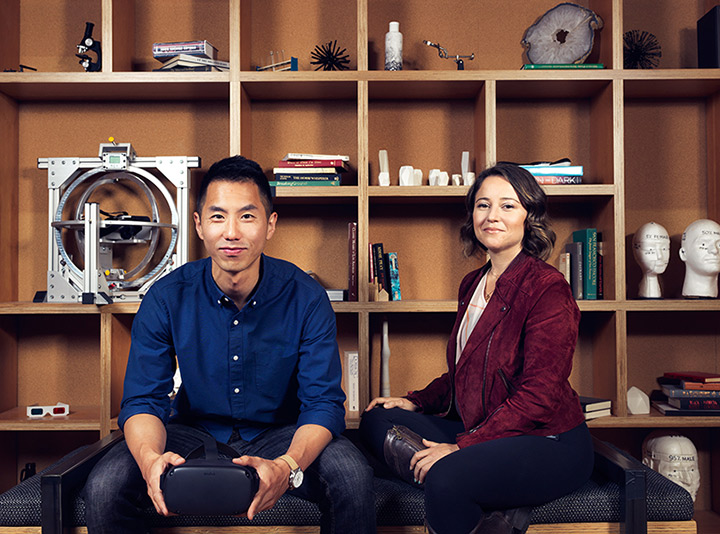
|
但Oculus Quest的用途并非建筑領(lǐng)域,,而是在游戲上,。和該設(shè)備一起發(fā)布的游戲有50多款,其中最受歡迎的莫過(guò)于色彩絢麗,、節(jié)奏明快的《節(jié)奏空間》(Beat Saber),,它由捷克獨(dú)立游戲工作室Beat Games開發(fā)和發(fā)行。對(duì)它的最恰當(dāng)描述是跳舞機(jī)游戲《Dance Dance Revolution》和RPG游戲《星球大戰(zhàn)》(Star Wars)的結(jié)合體,。今年3月,,《節(jié)奏空間》成為首款銷量超百萬(wàn)的VR游戲,而且其增長(zhǎng)勢(shì)頭沒(méi)有任何放緩跡象,。這得感謝YouTube上的活躍粉絲社區(qū),,他們發(fā)布的出色玩家視頻獲得了數(shù)百萬(wàn)的點(diǎn)擊量。今年4月,,《今夜秀》(Tonight Show)的主持人吉米·法倫和女演員布麗·拉爾森雙雙在這檔全國(guó)性節(jié)目上玩了這款游戲,。這讓大聲叫好的VR愛(ài)好者們幾乎喘不上氣來(lái)。YouTube的知名up主納撒尼爾·德容(綽號(hào)“納斯”)在推特上說(shuō):“這太棒了,!這是整個(gè)VR行業(yè)的真正殺手級(jí)營(yíng)銷,。” 玩了15分鐘的《節(jié)奏空間》后,,我已經(jīng)出汗了,。Beat Games的CEO雅羅斯拉夫·貝克說(shuō),你“在自己不知道的情況下鍛煉了身體,。你用最有沖擊力的方式感受了音樂(lè),,因?yàn)槟闶窃谟蒙眢w在感受它”。從設(shè)計(jì)人員到投資者,,再到公司高管,,整個(gè)行業(yè)的從業(yè)者都說(shuō)它是目前最接近“殺手級(jí)app”的產(chǎn)品,,或者說(shuō)消費(fèi)者會(huì)為了這款精彩的游戲而購(gòu)買VR頭盔,。這正是Facebook設(shè)立Oculus Studios時(shí)希望看到的情況,后者為Beat Games這樣的第三方游戲開發(fā)商提供資金和技術(shù)建議,。 Facebook對(duì)VR的最初愿景可比游戲龐大得多,。它認(rèn)為電影式的虛擬現(xiàn)實(shí)有望成為突破性應(yīng)用,而創(chuàng)造那些杰作的并非第三方開發(fā)商,,而是它自己,。2015年,F(xiàn)acebook成立了專門為虛擬現(xiàn)實(shí)制作電影的內(nèi)部機(jī)構(gòu)Oculus Story Studio,。但盡管憑借動(dòng)畫短片《Henry》贏得了一座艾美獎(jiǎng),,F(xiàn)acebook還是在2017年關(guān)閉了這個(gè)部門。曾經(jīng)在Oculus Story Studio工作的執(zhí)行制作人葉蓮娜·萊切斯基說(shuō)Facebook意識(shí)到自己的影響力更適合去激勵(lì)一個(gè)生態(tài)系統(tǒng)模式,。她解釋道:“我覺(jué)得現(xiàn)實(shí)情況就是在一家大公司里未必會(huì)出現(xiàn)許多創(chuàng)造性活動(dòng),。在我看來(lái),,外面那些不受特定公司結(jié)構(gòu)限制或制約的創(chuàng)作者擁有的創(chuàng)新和創(chuàng)造性思路會(huì)不斷地拓展VR的疆域?!?/p> 好萊塢在Facebook的VR夢(mèng)里位置超然,。愛(ài)德華·薩奇是Oculus Story Studio的創(chuàng)始成員。他的父親莫里斯是薩奇廣告公司的創(chuàng)始人之一,。愛(ài)德華說(shuō)他們的目標(biāo)是創(chuàng)作出可能“給整個(gè)行業(yè)帶來(lái)靈感”的VR內(nèi)容,。他還介紹說(shuō),大約五年前,,對(duì)這一技術(shù)的前景感興趣的幾位好萊塢導(dǎo)演曾經(jīng)和時(shí)任Oculus CEO的布倫丹·艾里布接觸過(guò),。愛(ài)德華現(xiàn)在領(lǐng)導(dǎo)著一家名為Fable的“虛擬存在”公司,他說(shuō):“他們超級(jí)興奮,,說(shuō):‘咱們來(lái)拍一部VR電影吧,。’艾里布卻回答說(shuō):‘我不知道怎么拍,?!?據(jù)愛(ài)德華介紹,Oculus設(shè)立Oculus Story Studio的目的是想知道怎么拍這樣的電影,?!拔覀兊哪繕?biāo)是讓電影學(xué)院開設(shè)VR電影課程,讓電影節(jié)接受VR電影,,讓著名導(dǎo)演去拍VR電影,。”他指出,,憑借《鳥人》(Birdman)拿下2014年奧斯卡最佳影片獎(jiǎng)的導(dǎo)演亞利桑德羅·岡薩雷斯·伊納里圖在2017年通過(guò)VR短片《血肉與黃沙》(Carne y Arena)又獲得了一個(gè)奧斯卡獎(jiǎng),。“所以,,從這個(gè)角度來(lái)說(shuō),,我們成功了。只是它還沒(méi)有成為主流,。除了主題公園,,還沒(méi)有任何跡象表明有什么人愿意出錢來(lái)做敘事性VR內(nèi)容?!?/p> |
But the Quest is not about architecture; it’s about games. More than 50 of them launched with the device, none more popular than the colorful rhythmic sensation Beat Saber, developed and published by indie Czech studio Beat Games. Best described as Dance Dance Revolution meets Star Wars, Beat Saber in March became the first VR game to claim to surpass 1 million copies sold, and it shows no signs of slowing down. That’s thanks to an active fan community on YouTube, generating millions of hits from videos showcasing standout players. In April, it was featured on a Tonight Show segment with the host Jimmy Fallon and actress Brie Larson each playing the game on national television. VR enthusiasts nearly hyperventilated in their praise. “This is huge!” tweeted popular VR YouTuber Nathani?l “Nathie” de Jong. “True killer marketing for the entire VR industry.” After 15 minutes of playing the game, I am sweating. You’re “exercising without knowing you are,” says Beat Games CEO Jaroslav Beck. “You are feeling the music in the most powerful way because you are physically experiencing it.” People across the industry, from developers to investors to company executives, say that this is, right now, the closest thing VR has to a “killer app”—a piece of content so good that it’s possible consumers will buy VR headsets just to play the game. It’s exactly the kind of outcome Facebook hoped for when it started Oculus Studios, a division that gives funding and technical advice to third-party game developers like Beat Games. Facebook’s initial vision for VR was far grander than games. It thought cinematic virtual reality would be a breakthrough application and that Facebook itself, rather than third-party developers, would create the masterpieces. Facebook established the Oculus Story Studio in 2015 as an in-house film department dedicated to making movies for virtual reality. Yet despite winning an Emmy for its animated short “Henry,” Facebook shuttered the studio in 2017. Yelena Rachitsky, a Facebook executive producer who’d been with the defunct studio, says Facebook realized its clout was better deployed encouraging an ecosystem approach. “I think there is just a reality that a lot of the creativity doesn’t necessarily happen within a big corporation,” she explains. “It’s the creators out there who aren’t limited or confined by specific corporate structures [who] I think have the innovative and creative thoughts that are going to continue to push the boundaries in VR.” Hollywood also figured prominently in Facebook’s VR dreams. Edward Saatchi, whose father, Maurice, cofounded the ad agency Saatchi & Saatchi, was a founding member of the Oculus Story Studio. He says the goal was to create VR content that could “inspire an industry.” Five or so years ago, Hollywood directors approached then Oculus CEO Brendan Iribe, intrigued by the technology’s prospects, says Saatchi, who now heads a “virtual beings” company called Fable. “They were super excited and said, ‘Let’s make a VR movie.’ But he was like, ‘I have no idea how to do that.’?” The Story Studio was Oculus’s attempt to find out how. “Our goal was to get film schools teaching VR movies, to have film festivals accepting VR movies, to have famous directors do VR movies,” Saatchi explains, noting that director Alejandro González I?árritu, whose Birdman won an Academy Award for Best Picture in 2014, took home another Oscar for his 2017 VR short, Carne y Arena. “So, in that sense, we succeeded. Except it didn’t become a mainstream thing. There just isn’t any evidence that anyone is willing to pay for narrative VR content outside of a theme park.” |
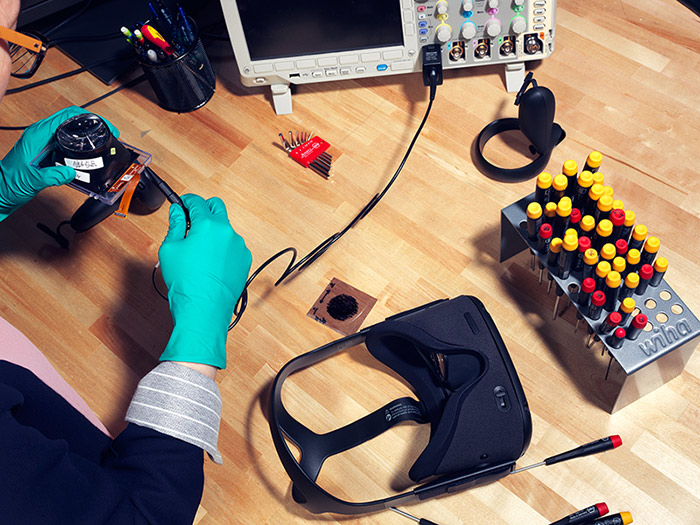
|
回頭看去,馬克·扎克伯格當(dāng)時(shí)是如此癡迷于VR的理論性潛力,,以至于他在投入幾十億美元時(shí)仍然沒(méi)有想清楚怎么把VR變成一門生意,。布萊克·哈里斯用樂(lè)觀的題目《未來(lái)的歷史:Oculus、Facebook和席卷VR的革命》(The History of the Future: Oculus, Facebook, and the Revolution That Swept Virtual Reality)寫過(guò)一本書,。他說(shuō):“扎克伯格有一個(gè)熱門app,。但在他心里,,借用別人的平臺(tái)總是個(gè)問(wèn)題。這要感謝微軟,、谷歌和蘋果,。” 的確,,扎克伯格和他的手下把VR描述為Facebook為數(shù)十億人創(chuàng)造社交體驗(yàn)的下一個(gè)邏輯落腳點(diǎn),。Facebook的VR產(chǎn)品管理負(fù)責(zé)人西恩·劉說(shuō),就像它把維系友情的模擬行為數(shù)字化一樣,,現(xiàn)在Facebook想讓人們?cè)谔摂M現(xiàn)實(shí)里“跨越地域界限,。我們真的在考慮并推動(dòng)這樣的概念,讓人民及其虛擬化身進(jìn)入虛擬現(xiàn)實(shí)中,。我們?cè)鯓硬拍軌蜃屓藗冋故颈砬椴⒆龀錾缃槐硎?,從而真正地相互連接并且進(jìn)行各種各樣的活動(dòng)呢?” 在現(xiàn)實(shí)社會(huì),,迄今為止VR還沒(méi)有成為流行通信工具,。但這并不妨礙Facebook對(duì)它的熱情。扎克伯格在去年的投資者電話會(huì)議上說(shuō):“我不知道VR什么時(shí)候會(huì)變得重要起來(lái),。我們剛開始談?wù)撨@個(gè)問(wèn)題時(shí),,我曾經(jīng)說(shuō)它真正成為非常主流的東西以及一個(gè)主要平臺(tái)需要10年時(shí)間?!辈畈欢?年過(guò)去了,,但這項(xiàng)未來(lái)派技術(shù)距離實(shí)現(xiàn)扎克伯格預(yù)想的情景還很遙遠(yuǎn)。 |
In retrospect, Mark Zuckerberg was so enamored with the theoretical potential of VR that it appears he spent billions without having thought through how to make a business of it. “It was a platform play,” says Blake Harris, author of the optimistically titled The History of the Future: Oculus, Facebook, and the Revolution That Swept Virtual Reality. “He had a popular app. But in his mind there’s always going to be this problem of living on other people’s platforms. You’re beholden to Microsoft, Google, and Apple.” Indeed, Zuckerberg and his minions have described VR as the logical next step in the social experience Facebook itself created for billions of people. Just as it digitized the analog behavior of keeping up with one’s friends, now Facebook wants people inside a virtual reality to “span geographical boundaries,” as Facebook director of VR product management Sean Liu says. “We’re really thinking and pushing the notion of how we bring you and your avatar into VR. How do we allow you to emote and have social expression to really connect together and do different activities?” In the reality we live in today, VR isn’t a prevalent tool of communication. But that hasn’t dampened Facebook’s enthusiasm for it. “I don’t know exactly when it’s going to be a big deal,” Zuckerberg said in a call with investors last year. “When we started talking about this, I said that I thought that this is going to be a 10-year journey before this was really a very mainstream and major platform.” Just about halfway down the road, the futuristic technology is nowhere near realizing Zuckerberg’s vision. |
****
|
一名帶著面具的搶劫犯拿槍對(duì)著我,,他把我和一位不停啜泣的女士推進(jìn)了后面的一個(gè)房間,。他喊道:“拿著這個(gè)該死的袋子,撿起來(lái),,把東西裝進(jìn)去,。所有東西!”現(xiàn)在他正朝著一面白色的墻走去,,墻上擺滿了包裝好的手機(jī)和配件,。在我們有所反應(yīng)前出現(xiàn)了一道閃光,一陣呼呼的噪音,,然后時(shí)間突然向前跳了。那位女士開始慌張地把電子產(chǎn)品裝到袋子里,。那個(gè)搶劫犯的同伙喊道:“快點(diǎn),!我們走!”然后是一片黑暗,。 我摘下Oculus Go頭盔,,四周明亮而安詳,,我正坐在曼哈頓熨斗區(qū)一座不起眼的寫字樓里,斯坦福大學(xué)教授,、該校虛擬人機(jī)交互實(shí)驗(yàn)室創(chuàng)始負(fù)責(zé)人杰里米·貝倫森站在我身邊,。他向我解釋了剛才看到的影像,那是為威瑞森門店員工制作的VR培訓(xùn)材料,,教他們?nèi)绾螒?yīng)對(duì)手持武器的搶劫犯,。貝倫森說(shuō):“如果你在威瑞森的店里工作,你會(huì)發(fā)現(xiàn)很多貴重商品就放在靠近門口的地方,。每年這些店都會(huì)遭到幾十次持槍搶劫,。他們希望通過(guò)培訓(xùn)讓員工知道怎么保證自身安全?!倍嗄陙?lái)威瑞森一直采用傳統(tǒng)培訓(xùn)方法——在教室里講解,,并請(qǐng)演員來(lái)充當(dāng)劫匪。但該公司發(fā)現(xiàn)這種方法收效甚微,。威瑞森的全球培訓(xùn)副總裁盧·特德里克說(shuō):“雖然已經(jīng)培訓(xùn)過(guò)了,,但[我們的員工]未必能夠應(yīng)付搶劫。我們覺(jué)得用VR可能是個(gè)好辦法,,因?yàn)樗兄谠鰪?qiáng)遭到搶劫時(shí)的記憶,。我們想在安全環(huán)境下讓人們感受它,而且可以就此展開討論,?!?/p> |
The masked robber points a gun in my face and shuffles me and a sobbing woman into a back room. “Take this fucking bag, pick it up, and fill it up!” he screams. “Everything!” Now he’s motioning toward a white wall lined with packaged phones and accessories. Before we can react, a flash, a whirring noise, and then time cuts forward. The woman is now stuffing electronics into the bag, panicked. “Hurry the fuck up!” the robber’s accomplice shouts. “Let’s go!” And then black. As I remove my Oculus Go headset, all is bright and peaceful in an empty classroom inside an unassuming office building in Manhattan’s Flatiron District. Jeremy Bailenson, a Stanford professor and founding director of the university’s Virtual Human Interaction Lab, stands beside me. He begins explaining what I have just witnessed: a VR training module for Verizon store employees to learn how to deal with armed robberies. “If you work at a Verizon store, there’s so much expensive material that’s right near the door,” he says. “They have dozens of robberies at gunpoint each year. They want to train their employees to be safe.” Verizon had been offering traditional training procedures for years, utilizing classroom instruction and hiring actors to simulate robberies. But the company found it minimally effective. “Despite having been trained, [our employees] weren’t necessarily equipped to manage through the robbery,” says Lou Tedrick, Verizon’s vice president of global learning. “We thought VR would be a good use case because it would help the muscle memory of what it had felt like to be robbed. You want to be able to feel it in a safe environment and be able to talk about it.” |
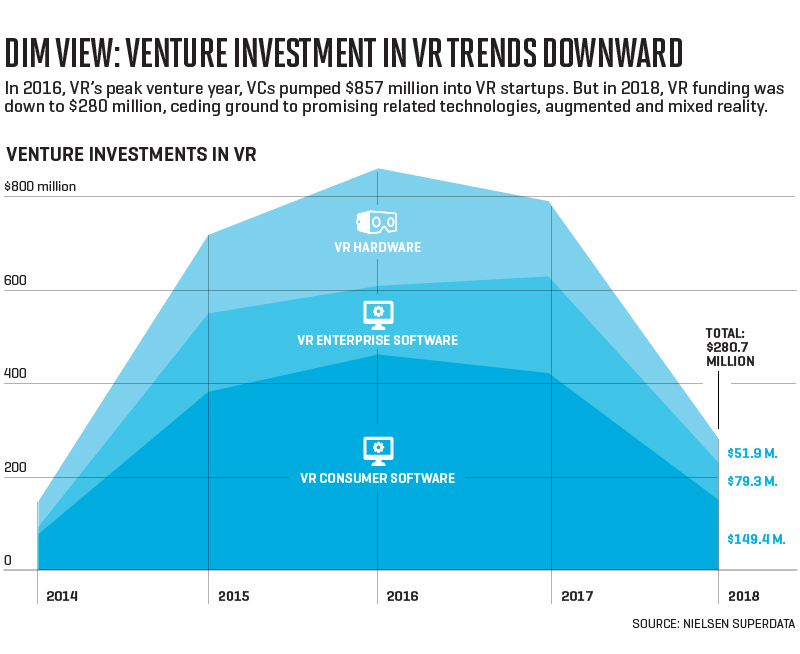
|
為改善安全培訓(xùn),威瑞森找到了貝倫森2015年創(chuàng)立的VR培訓(xùn)公司Strivr,,后者和沃爾瑪?shù)绕渌蠊镜暮献鹘o威瑞森留下了深刻印象,。他們請(qǐng)Strivr為其開發(fā)模塊,用于訓(xùn)練店鋪經(jīng)理應(yīng)對(duì)高度還原的搶劫場(chǎng)景,。從2018年年底開始,,1500名威瑞森門店經(jīng)理接受了Strivr的培訓(xùn)。在調(diào)查中,,95%的經(jīng)理表示他們更明白了面對(duì)真正搶劫時(shí)自己需要考慮的因素,。對(duì)于故意給員工帶來(lái)心理創(chuàng)傷的道德問(wèn)題,特德里克說(shuō)專業(yè)培訓(xùn)人員會(huì)帶領(lǐng)員工一步步地完成培訓(xùn),,她還指出:“實(shí)際上,,許多人都對(duì)我們表示感謝,因?yàn)槲覀儎?chuàng)造了一種無(wú)比真實(shí)的體驗(yàn),,而不是設(shè)法弱化這種經(jīng)歷,。”威瑞森現(xiàn)在計(jì)劃讓所有的店鋪經(jīng)理都參加這些VR仿真培訓(xùn),。 實(shí)際情況表明,,雖然VR電影或虛擬聚會(huì)還沒(méi)有迎來(lái)全盛時(shí)期,,但這項(xiàng)技術(shù)非常適合某些實(shí)際性應(yīng)用。在外科手術(shù)培訓(xùn),、STEM(科學(xué),、技術(shù)、工程,、數(shù)學(xué))教育,、工業(yè)設(shè)計(jì)、建筑,、房地產(chǎn)等領(lǐng)域,,VR已經(jīng)越來(lái)越受歡迎。在Facebook于今年4月舉辦的F8開發(fā)者大會(huì)上,,Oculus宣布一個(gè)更大的Oculus商業(yè)項(xiàng)目定于今年秋天開始,,它包括讓開發(fā)者接觸到Oculus Quest這樣的企業(yè)級(jí)頭盔以及“一套專門軟件,可以提供設(shè)備設(shè)置,、管理工具,、企業(yè)級(jí)服務(wù)和支持以及為商業(yè)應(yīng)用定制的用戶新體驗(yàn)”。與此同時(shí),,微軟和HTC已經(jīng)開始分別向工業(yè)企業(yè)大量推廣使用混合現(xiàn)實(shí)技術(shù)的HoloLens和HTC Vive頭盔,。HTC美國(guó)Vive產(chǎn)品線總經(jīng)理丹·奧布里恩說(shuō):“消費(fèi)者方面的市場(chǎng)更大,但我們?cè)谄髽I(yè)領(lǐng)域里的增長(zhǎng)更為迅猛,?!?/p> 給威瑞森提供培訓(xùn)服務(wù)的Strivr只專注于B2B VR應(yīng)用。除了這家大型電信公司,,它的客戶還包括Chipotle,、捷藍(lán)航空、富達(dá)投資和泰森食品,。該公司已經(jīng)向全美國(guó)的沃爾瑪超市和較小的沃爾瑪門店推出了1.7萬(wàn)個(gè)安裝了Strivr軟件的Oculus Go頭盔,,而且全都是為了內(nèi)部使用。這家初創(chuàng)企業(yè)表示,,它可以通過(guò)這些頭盔追蹤人們的表現(xiàn)和眼睛的運(yùn)動(dòng),,進(jìn)而提供分析。Strivr的CEO及聯(lián)合創(chuàng)始人,、也是貝倫森帶過(guò)的研究生德里克·貝爾奇說(shuō):“當(dāng)一家公司跟我們說(shuō),,‘我需要確定接受培訓(xùn)的人是在看著地上的桶’,根據(jù)VR培訓(xùn)的分析,,我們就可以告訴他那人并沒(méi)有這樣做,。也就是說(shuō)在真實(shí)世界中他們不會(huì)看著那個(gè)桶。對(duì)此我們毫不含糊,?!?/p> 企業(yè)技術(shù)應(yīng)用比消費(fèi)型版本更早取得商業(yè)成功并非罕見(jiàn)現(xiàn)象。貝爾奇說(shuō)他家就沒(méi)有VR頭盔,。Strivr的支持者之一,、門洛帕克投資機(jī)構(gòu)Signia Venture Partners的創(chuàng)始合伙人佐·賽特顯然對(duì)自己的公司押寶一款企業(yè)應(yīng)用感到很滿意。他說(shuō):“消費(fèi)領(lǐng)域還沒(méi)有殺手級(jí)app,。沒(méi)錯(cuò),,僵尸屋能在10分鐘內(nèi)嚇你一跳,我四歲的兒子喜歡對(duì)著太陽(yáng)系看上5分鐘,。但他不會(huì)天天如此,。” |
To improve its safety training, Verizon approached Strivr, a VR software training company Bailenson cofounded in 2015. Impressed by the startup’s work with other large corporate partners like Walmart, Verizon tasked Strivr with developing modules to train store managers in high--fidelity heist scenarios. Since late 2018, roughly 1,500 of these managers have undergone Strivr’s training experiences. When surveyed, 95% said they better understood the factors they would need to consider during an actual burglary attempt. Asked about the ethical concerns of purposefully traumatizing employees, Tedrick says that professional trainers walk employees through every step of the way. “In fact, we had many people thank us for creating an incredibly realistic experience versus trying to sanitize the experience,” she adds. Verizon now plans to have store managers at all its retail locations trained in these VR simulations. It turns out that while VR movies or virtual hangouts may not be ready for prime time, the technology is ideal for certain practical applications. VR is gaining traction in fields like surgical training, STEM education, industrial design, architecture, real estate, and more. At Facebook’s F8 developer conference in April, Oculus announced an expanded Oculus for Business program slated to begin in the fall. It includes access to enterprise-grade headsets, such as the new Oculus Quest, and “a dedicated software suite offering device setup and management tools, enterprise-grade service and support, and a new user experience customized for business use cases.” Microsoft and HTC, meanwhile, have pushed heavily into industrial enterprise with the mixed-reality HoloLens headset and the HTC Vive, respectively. “Our bigger market is on the consumer side,” says HTC’s Dan O’Brien, general manager of the Americas for the Vive product line. “But our more aggressive growth area is enterprise.” Strivr, the Verizon vendor, is solely focused on business-to-business VR applications. In addition to the giant phone company, it counts Chipotle, Jet Blue, Fidelity Investments, and Tyson Foods as clients. It has distributed 17,000 Oculus Go headsets embedded with Strivr’s software in Walmart superstores and smaller stores across the country, all for internal use. From there, the startup says it can provide analytics that track performance and eye movement. “When a company tells us, ‘I need to know that the trainee looked at that bucket on the floor,’ we can tell you that they did not look at it,” says Strivr CEO and cofounder Derek Belch, a former graduate student of Bailenson’s. “That means they’re not going to look at it in the real world. Like, unequivocally.” It isn’t unusual for business technology applications to find commercial success before their consumer versions do. Belch of Strivr says he doesn’t own a headset at home. One of Strivr’s backers, Zaw Thet of Signia Venture Partners in Menlo Park, Calif., is clearly pleased with his firm’s bet on an enterprise application. “There isn’t a killer app here on the consumer side,” he says. “Yeah, in 10 minutes you can get scared in a zombie house, and my 4-year-old likes to go look at the solar system for five minutes. But it’s not something he’s in every day.” |
****
|
除了價(jià)格,、不舒適以及缺乏好內(nèi)容外,,還有什么原因妨礙了VR使用者的增長(zhǎng)呢? VR會(huì)讓人們完全脫離現(xiàn)實(shí),。說(shuō)實(shí)話,,誰(shuí)有時(shí)間那么做呢?早期投資機(jī)構(gòu)沙斯塔創(chuàng)投的合伙人雅各布·穆林斯說(shuō):“你在一座圍起來(lái)的花園里,,在一個(gè)頭盔里,,跟真實(shí)世界沒(méi)有任何聯(lián)系?!?/p> 實(shí)際上,,VR在改變方法后取得了一定成功,特別是通過(guò)增強(qiáng)現(xiàn)實(shí)(AR)技術(shù),。AR的特征和VR類似,,但它不是以完全沉浸的方式讓使用者進(jìn)入另一個(gè)現(xiàn)實(shí),而是將數(shù)字元素添加到現(xiàn)實(shí)世界中,,通常是在智能手機(jī)上,。大家可以想想手游《口袋精靈》(Pokémon Go)或者宜家的app,它能為用戶模擬出新家具擺在他們家里的模樣,。隨著對(duì)VR的信心減弱,,AR現(xiàn)在開始經(jīng)歷五年前VR熱潮中的那種炒作——初創(chuàng)公司Magic Leap籌集了近25億美元來(lái)開發(fā)AR眼鏡和相關(guān)內(nèi)容。就連Facebook也在“對(duì)沖”自己的投資,。今年早些時(shí)候,,該公司將Facebook Reality Labs的數(shù)百名員工轉(zhuǎn)移到了一個(gè)專門開發(fā)AR硬件的團(tuán)隊(duì)中。Facebook Research網(wǎng)站信誓旦旦地表示:“將來(lái),,我們的AR眼鏡將讓真實(shí)世界和數(shù)字世界合二為一,,把現(xiàn)實(shí)與可能結(jié)合在一起,進(jìn)而打造出新的主流必備可穿戴消費(fèi)技術(shù)?!?/p> |
Why don’t more people use virtual reality—besides the issues of price, discomfort, and lack of good content? Because VR requires you to completely abandon reality. And, honestly, who has time for that? “You’re inside of a walled garden, you’re inside of a headset where you don’t have access to the real world,” says Jacob Mullins, a partner at Shasta Ventures, an early backer of the technology. In fact, where VR has found limited success is by tweaking its approach, especially with augmented reality. AR shares similar properties with VR, but rather than completely immersing a viewer in another reality, it adds digital elements to the real world, typically through a smartphone. Think of Pokémon Go or the Ikea app that enables users to place and visualize new furniture within their homes. As confidence in virtual reality falters, AR is now experiencing levels of hype similar to the VR wave of five years ago, with startups like Magic Leap raising close to $2.5 billion to develop AR glasses and related content. Even Facebook is hedging its bets. Earlier this year, it moved hundreds of employees from its Facebook Reality Labs research division to a team dedicated to AR hardware projects. “In the future, our AR glasses will merge the physical and digital worlds, blending what’s real with what’s possible, resulting in the next mainstream, must-have, wearable consumer technology,” promises a Facebook Research web page. |
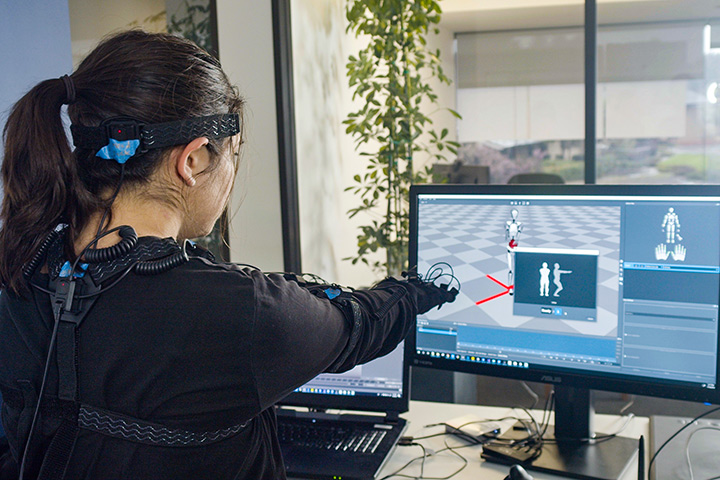
|
一些人的思路是改進(jìn)我們的世界也許比取代它或者創(chuàng)造一個(gè)新世界更有吸引力,。由于AR技術(shù)不像VR那么成熟,純粹的消費(fèi)型AR眼鏡依然很遙遠(yuǎn),,但AR已經(jīng)可以廣泛使用在智能手機(jī)上了,,這要感謝蘋果推出了一系列軟件開發(fā)工具,讓簡(jiǎn)單易用的應(yīng)用成為可能,。比如,,這項(xiàng)技術(shù)很受塔吉特、沃爾瑪和Bed Bath & Beyond等零售商歡迎,,它們都在自己的iPhone app上加入了AR功能,,以便顧客在購(gòu)物前查看商品的模樣。 風(fēng)投趨勢(shì)從VR到AR的轉(zhuǎn)變尤其明顯,。穆林斯說(shuō):“我對(duì)這兩種技術(shù)同樣感興趣,,但作為投資者,我不得不關(guān)注有消費(fèi)者,、市場(chǎng)機(jī)遇以及需求的領(lǐng)域,。兩年前,VR看來(lái)更令人興奮,,而且會(huì)有更大的規(guī)模,。但后來(lái)蘋果讓3億多部設(shè)備有了AR功能,而且這個(gè)數(shù)字還在增長(zhǎng),?!钡拇_,SuperData 的數(shù)據(jù)顯示,,2016年,,也就是VR風(fēng)投達(dá)到頂峰的那一年,風(fēng)險(xiǎn)投資公司為VR初創(chuàng)企業(yè)注入了8.57億美元資金,,而AR和MR,,也就是能夠讓數(shù)字影像和真實(shí)世界互動(dòng)的混合現(xiàn)實(shí)技術(shù)獲得的總投資也只有4.55億美元。但2018年,,這兩個(gè)數(shù)字出現(xiàn)了反轉(zhuǎn),,VR投資降至2.8億美元,對(duì)AR和MR的投資則猛增至8.59億美元,。 還有一個(gè)不斷成長(zhǎng)的領(lǐng)域也找回了VR最初的承諾,,那就是娛樂(lè)行業(yè),。這種吸引人的商業(yè)應(yīng)用被稱為“基于位置的娛樂(lè)”(LBE)。一大批公司開始推出一種實(shí)際上跨越了商場(chǎng)和電影院的業(yè)態(tài),,并以主題公園為之冠名,。在這些實(shí)體店鋪中,消費(fèi)者在定制空間用VR技術(shù)自由行動(dòng),,他們會(huì)組成一個(gè)小群體,。戴上Oculus,、HTC等公司的VR頭盔后,,他們就會(huì)以虛擬化身的形象出現(xiàn)在其他參與者眼中。有一些體驗(yàn)比較像游戲,,參與者會(huì)拿著塑料模型槍,。其他則更像是和觀眾互動(dòng)的敘事性電影。和個(gè)人戴著頭盔的VR應(yīng)用相比,,LBE還有一項(xiàng)優(yōu)勢(shì),,那就是參與者身上綁著會(huì)振動(dòng)的觸感設(shè)備,從而讓人更加“樂(lè)在其中”,。有些場(chǎng)所甚至用電風(fēng)扇,、灑水器和加熱器來(lái)模擬刮風(fēng)、下雨或者炎熱天氣,。 Dreamscape Immersive是一家設(shè)在洛杉磯的LBE“展示機(jī)構(gòu)”,,它從21世紀(jì)福克斯,、華納兄弟和AMC等公司獲得了3600萬(wàn)美元投資,。好萊塢老牌制片人、Dreamscape Immersive的聯(lián)席董事長(zhǎng)沃爾特·帕克斯表示,,該公司希望用沉浸式敘事,,或者說(shuō)互動(dòng)式觀影體驗(yàn)來(lái)吸引消費(fèi)者。帕克斯說(shuō)他發(fā)現(xiàn)LBE比普通的家用VR更吸引人,,原因是用戶“在一個(gè)真正渲染出來(lái)的世界里,,是一個(gè)實(shí)實(shí)在在的人物,而且可以用所有感官和其他人交流”,。 VR信徒的期望是LBE等概念能為VR(以及AR和MR)全面得到應(yīng)用闖出一條路來(lái),,就像電影院引出了其他觀影方式一樣。Dreamscape Immersive的票價(jià)為20美元,,和平均電影票價(jià)相差不大,,只是它的觀看時(shí)間要短得多,只有20分鐘左右,。在不斷壯大的LBE公司群體中,,The Void收費(fèi)最高。它在美國(guó)、加拿大等四個(gè)國(guó)家設(shè)有11家門店,。該公司時(shí)長(zhǎng)30分鐘的《Secrets of the Empire》體驗(yàn)收費(fèi)35美元,,參與者會(huì)在一個(gè)巖漿四溢的星球上潛入銀河帝國(guó)基地并和帝國(guó)沖鋒隊(duì)?wèi)?zhàn)斗(該影片獲得了星球大戰(zhàn)及其他迪士尼重磅IP授權(quán))。The Void等公司也在推動(dòng)VR向前發(fā)展,,因?yàn)樗鼈冏屜M(fèi)者有機(jī)會(huì)以低價(jià)來(lái)體驗(yàn)這項(xiàng)技術(shù),。Gartner研究部門分析師阮祥指出:“它降低了投資門檻?!?/p> |
The thought for some is that perhaps it’s more compelling to enhance our world than to replace it or create a new one. While stand-alone consumer AR glasses are still a ways away because the technology is less developed than VR, AR is already widely available on smartphones, thanks to Apple’s release of a set of software development tools enabling easy-to-use applications. The tech has proved popular with retailers, for example, including Target, Walmart, and Bed Bath & Beyond, each of which has incorporated AR features into its iPhone app to help shoppers visualize purchases. The pivot from VR to AR is particularly noticeable in venture capital trends. “I’m equally interested in both, but as an investor, I’m forced to have to pay attention to where the customer and market opportunity and demand is,” Mullins says. “Two years ago, VR appeared to have more excitement and scale behind it. But then Apple essentially enabled 300 million–plus devices and growing.” Indeed, in 2016, VR’s peak venture year, VCs pumped $857 million into VR startups, according to SuperData; AR and MR, or mixed reality—which allows virtual imagery to actually interact with the real world—received just $455 million combined. But in 2018, the equation had flipped: VR funding was down to $280 million, while AR/MR jumped to $859 million. Another burgeoning approach has found its way back to the original promise of VR: entertainment. This compelling commercial application is called “l(fā)ocation-based entertainment,” or LBE. A crop of companies are operating what is essentially a cross between an arcade and a movie theater, with a dash of theme park. These are brick-and-mortar venues where participants use virtual reality in custom-designed spaces, freely moving alongside a small group of fellow participants who appear to each other as avatars when wearing VR headsets manufactured by Oculus, HTC, and others. Some of these experiences play out more like games, with participants wielding plastic-model guns. Others are more like a narrative film that viewers interact with. LBE experiences offer another advantage over headset-bound, individual VR uses. They further immerse users by having them strap on haptic equipment that vibrates. Some venues even feature fans, sprinklers, and heaters to simulate conditions such as wind, water, or heat. Dreamscape Immersive is a Los ?Angeles–based LBE “exhibitor” that’s raised $36 million from the likes of 21st Century Fox, Warner Bros., and AMC. It hopes to entice customers with immersive narratives, a kind of interactive moviegoing experience, says Hollywood veteran Walter Parkes, a Dreamscape cochairman. Parkes says he finds LBE more compelling than typical in-home VR—in other words, a single user wearing a headset—because users are an “actual character in a real, rendered world with other people able to be in touch with all of [their] senses.” The hope among VR adherents is that concepts like LBE will act as a gateway to overall VR (and AR and MR) adoption, in the same way cinemas begot additional ways to watch movies. Dreamscape charges $20 for its experiences, not too far off the average price of a movie ticket, though its run times are much shorter, at around 20 minutes. The Void, the most expansive of a burgeoning collection of LBE companies, with 11 locations in four countries including the U.S. and Canada, charges about $35 for its 30-minute Secrets of the Empire experience, in which you get to infiltrate an Imperial base and shoot Stormtroopers on a molten-lava planet. (The firm has rights to Star Wars and other blockbuster Disney intellectual property.) Businesses like The Void also move VR forward because they make it possible for consumers to experience the technology without spending serious ?money. “It takes down that investment barrier to entry,” says Tuong Nguyen, an analyst at Gartner research. |
****
|
此前我已經(jīng)體驗(yàn)了許多VR產(chǎn)品,。Oculus的、HTC的,、谷歌的,、電影、視頻游戲以及職業(yè)仿真培訓(xùn),??倳?huì)有人幫助我戴上頭盔,幫助我為這些體驗(yàn)做好準(zhǔn)備,。但體驗(yàn)開始后這些人就消失了,。盡管我會(huì)在新的現(xiàn)實(shí)中看到其他人或別的東西,盡管我仍然有可能聽到原來(lái)的現(xiàn)實(shí)中有人在說(shuō)話,,但我總是獨(dú)自一人,。 進(jìn)入Dreamscape Immersive設(shè)在洛杉磯Westfield購(gòu)物中心的外星人公園時(shí),我正在想人們通常會(huì)怎樣描述他們的VR體驗(yàn),。他們會(huì)飛越曼哈頓的天際線,,潛入太平洋底,或者飛向外太空,。而且他們總是用“我”這個(gè)詞,。我現(xiàn)在也在太空中。但這一次明顯不同,,在這里的不是“我”,,而是“我們”。剛才我和伙伴們一起在手上和腳上綁上了閃爍著藍(lán)光的傳感器,,還背上了裝有計(jì)算機(jī)的背包,。我們走進(jìn)黑暗而且空蕩蕩的房間,把頭盔拉下來(lái)遮住眼睛,,然后看著隊(duì)友們一個(gè)個(gè)地變成虛擬形象,。我們的引導(dǎo)員讓我們揮手,以表明自己看到了這個(gè)令人震撼的現(xiàn)實(shí)和虛擬結(jié)合的場(chǎng)景,。接下來(lái)我們開始在這個(gè)生機(jī)勃勃的星球上捕獵,,這里有雷龍那么大的長(zhǎng)頸鹿和巨大的正在捕食的螳螂,,這些真的讓侏羅紀(jì)公園變得像一個(gè)尼安德特人的世界。這場(chǎng)體驗(yàn)震撼人心,,而且絕對(duì)物有所值?,F(xiàn)在,所有VR需要做的就是說(shuō)服數(shù)以億計(jì)的人們得出同樣的結(jié)論,。(財(cái)富中文網(wǎng)) 本文另一版本登載于《財(cái)富》雜志2019年7月刊,,標(biāo)題為《VR的興衰》。 譯者:Charlie 審校:夏林 |
I have tried many virtual reality products by now. Oculus’s and HTC’s and Google’s and films and video games and job-?training simulations. Someone was always there to strap me into the headsets, to prepare me for the experience. And then they were always gone when it started. And I was always alone, even if I saw other people, or things, inside the new reality, even if I could still hear people outside in the old reality. When I enter the Alien Zoo at Dreamscape, inside a Westfield mall in Los Angeles, I’m thinking about how people typically describe their VR experiences. They fly over the Manhattan skyline or dive into the Pacific or head for outer space. And they always use the word “I.” I, too, am now in space. But there’s a significant difference: It’s not “I”, it’s “we.” Moments ago, my partners and I strapped blue-lit haptic sensors around our hands and feet and slung computer-stuffed backpacks around our shoulders. We stepped into a dark, bare room; slid the headsets over our faces; and watched one another’s bodies transform into human avatars. Our Dreamscape minder instructed us to shake hands to confirm this astonishing mix of the physical and fake, and then we set off for a safari on a vibrant planet occupied by brontosaurus-giraffes and gigantic praying mantises that make Jurassic Park seem positively Neanderthal. It’s a mind-?blowing experience—and absolutely worth paying for. Now all virtual reality needs to do is to persuade hundreds of millions of people to arrive at the same conclusion. A version of this article appears in the July 2019 issue of Fortune with the headline “The Fall and Rise of VR.” |













